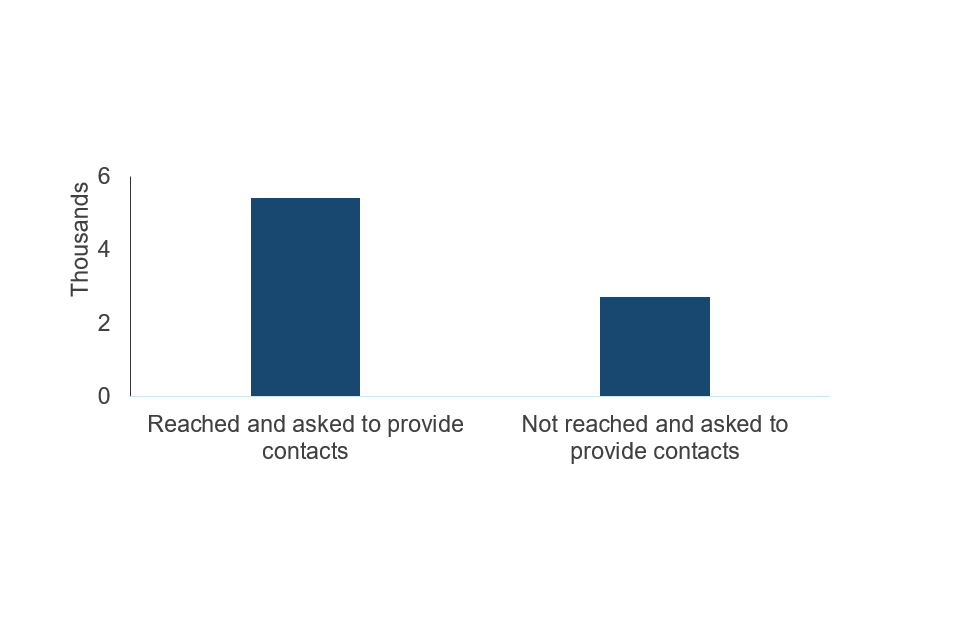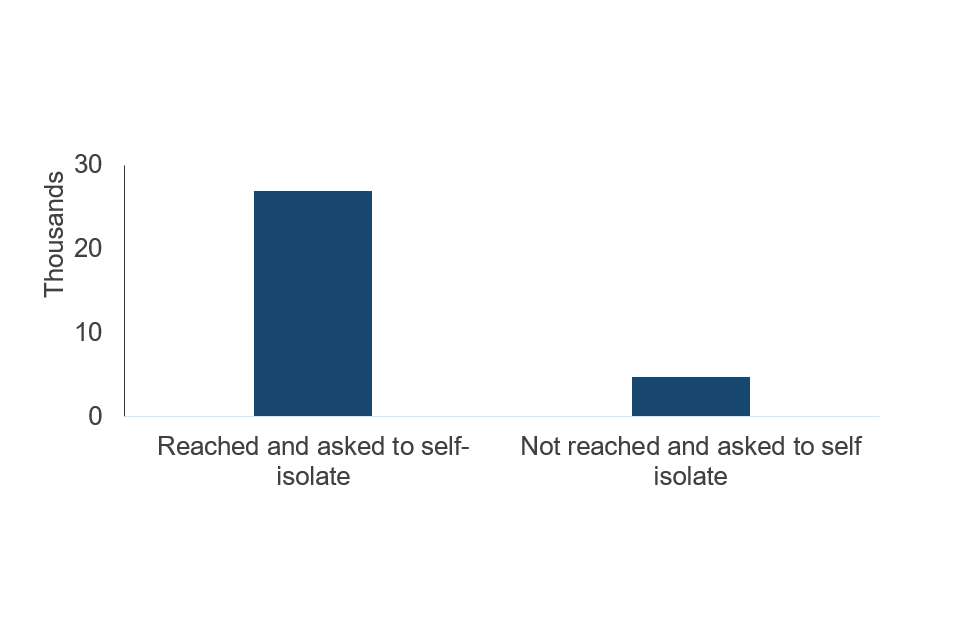Experimental statistics – weekly NHS test and trace bulletin, England: 28 May to 3 June 2020
Updated 11 June 2020
These figures have been revised. The most recent figures and reasons for the revisions are available in the latest report.
The data in the tables below reflect the first week of operation of the contact tracing element of NHS Test and Trace. They include contact tracing undertaken:
- online
- by local health protection teams
- by contact tracing staff
Main points
NHS contact tracing went live on 28 May.
Between 28 May and 3 June 2020:
- 8,117 people who tested positive for coronavirus (COVID-19) had their case transferred to the contact tracing system, of whom 5,407 were asked to provide details of recent contacts
- 31,794 contacts were identified
- of these 26,985 were reached and advised to self-isolate
Test and trace: number of cases in the contact tracing system
Table 1: number of people who tested positive for coronavirus whose details were transferred to the contact tracing system, England, 28 May to 3 June 2020
| Number of people | Percentage | |
|---|---|---|
| People who were reached and were asked to provide contacts | 5,407 | 67% |
| People who were not reached | 2,710 | 33% |
Total number of people: 8,117[footnote 1]
The number who were reached and asked to provide contacts includes those people who have tested positive for coronavirus who provided details about recent contacts or whose cases have been investigated as part of an outbreak.
The number who were not reached and asked to provide contacts includes those people who the service has been unable to reach as contact details were unavailable or incorrect, or where there has been no response to text, email and call reminders. This also includes people whose cases are currently being managed as part of active outbreak investigations.
About two-thirds of people whose cases were transferred to the contact tracing system were reached and asked to provide information about their contacts
Figure 1: cases transferred to the contact tracing system by provision of information about contacts, England, 28 May to 3 June 2020

Most people were reached and asked to provide information about contacts within 24 hours of their case being transferred to contact tracing
Figure 2: proportion of people who were reached and asked to provide information about contacts by time taken to do so, England, 28 May to 3 June 2020 [footnote 2]

Table 2: people who were reached and asked to provide information about contacts by time taken to do so, England, 28 May to 3 June 2020 [footnote 2]
| Within 24 hours | Between 24 and 48 hours | Between 48 and 72 hours | After 72 hours | |
|---|---|---|---|---|
| Number of people | 3,336 | 603 | 110 | 167 |
| Percentage | 79% | 14% | 3% | 4% |
Number of contacts identified
Table 3: number of contacts identified, England, 28 May to 3 June 2020
| Reached and asked to self-isolate | Not reached | |
|---|---|---|
| Number of people | 26,985 | 4,809 |
| Percentage | 85% | 15% |
Total number of contacts identified: 31,794
Contacts are those people who have been identified as being in close contact with someone who has tested positive for coronavirus. This includes those identified by local public health protection teams during the investigation of outbreaks.
However, the number of contacts identified as part of outbreak investigations is not always available. Investigations that are ongoing may not be included.
The service has been unable to reach some contacts. This could be where contact details were unavailable or incorrect, or where there has been no response to text, email and call reminders. Further, there are some contacts who were reached but have not agreed to self-isolate.
Over three-quarters of contacts were reached and were asked to self-isolate
Figure 3: number of contacts by whether they were reached and were asked to self-isolate, England, 28 May to 3 June 2020

Over three-quarters of contacts were reached and asked to self-isolate within 24 hours of being identified [footnote 3]
Figure 4: number of contacts who were asked to self-isolate by time taken to do so, England, 28 May to 3 June 2020 [footnote 3]

Table 4: contacts who were reached and were advised to self-isolate
| Within 24 hours | Between 24 and 48 hours | Between 48 and 72 hours | After 72 hours | |
|---|---|---|---|---|
| Number of people | 4,485 | 551 | 168 | 74 |
| Percentage | 85% | 10% | 3% | 1% |
Measuring the data
How the data were collected
These data are collected from management information from the NHS Test and Trace service.
Future development
Over June these data will be integrated with those from other parts of NHS Test and Trace, particularly testing, to provide an end-to-end view of the service that follows the user journey.
This will include both the numbers of people engaged and the speed of the journey through the service, including data on test turnaround times.
The intention is for the NHS Test and Trace service to publish weekly statistics. In addition, NHS Test and Trace will provide information for local authorities and their partners so that they have the information they need to help contain any outbreaks.
In time, NHS Test and Trace intends to publish detailed data from across the programme to support secondary analysis, for example in academic institutions. Over the coming weeks, as the service matures, more information will be provided on a weekly basis.
Quality
These statistics have been put together by NHS Test and Trace with advice from the Office for National Statistics on this approach.
Strengths and limitations
Given the importance of this service and the commitment of NHS Test and Trace to be open and transparent with the public it serves, these data are being released at the earliest possible opportunity.
However, new IT systems and statistical outputs often take a period of time to bed in. These data should therefore be treated with caution as the system and understanding of the data develops.
Experimental statistics
Experimental statistics are statistics that are in the testing phase and not yet fully developed.
Find out more about experimental statistics from the Governmental Statistics Service (GSS)
Related links
See further statistics on GOV.UK relating to testing (for example pillar testing).
-
This includes cases that were managed exclusively by local public health experts if they are complex; for example, if someone works in or has recently visited a health or care setting such as a hospital or care home, a prison or other secure setting, a school for people with special needs, or critical national infrastructure or areas vital for national security. ↩
-
Among people who provided information about contacts. Excludes those managed by local public health teams as part of outbreak investigations who on average have a higher number of contacts. ↩ ↩2
-
Among people who were reached and asked to self-isolate. Excludes those managed by local public health teams as part of outbreak investigations, which makes up high number of contacts identified. ↩ ↩2
